Rabbi Amichai Lau-Lavie is an Israeli-born, Jewish educator, writer, and performance artist. He's the creator of Storahtelling, Inc. and the founding spiritual leader of Lab/Shul in NYC, an artist-driven, everybody friendly, God-optional, pop-up experimental community for sacred Jewish gatherings.
Amichai is a member of the Global Justice Fellowship of the American Jewish World Service, a founding member of the Jewish Emergent Network, serves on the Leadership Council of the New York Jewish Agenda, the Advisory Council of the International School for Peace - a Refugee Support Project in Greece, a member of the Advisory Council for the Institute for Jewish Spirituality, and is a faculty member of the Reboot Network.
Through all his endeavors, he brings a creative, inclusive, and vital energy to Jewish practice and Jewish life.
EPISODE SUMMARY
In this conversation we talk about:
- How the Jewish concept of the set table served both as a happy early memory, and as an organizing principle for his later work.
- How Covid 19 made rituals and online communities more important than ever.
- His orthodox roots as the scion of an ancient and respected rabbinical dynasty, and his journey of self discovery through theater, drag, and art.
- His creation of storytelling, a way to bring to life the ancient ritual of the reading of the Torah, and the Maven Method he developed to spread the practice further.
- The emergence of Lab/Shul and the community around it.
- The power of spiritual design and a well-designed practice in transforming our lives and our communities for the better.
We also discuss:
- How is religion used as a tool in the service of humanity?
- What happens if you bring scripture to the 21st century as a performance?
- Why is the tribal wisdom of small circles within a bigger circle so important?
I've long believed that one of the most promising avenues to apply design skills and creativity to is in designing communities, social rituals, and spiritual practice that suits the modern world. And, as such, there's no one I can think of that exemplifies this better than Rabbi Amichai Lau-Lavie. I think this conversation, which is full of wisdom and fun, is a great introduction to exactly the type of spiritual design we need to see more of. So let's jump right in with Rabbi Amichai Lau-Lavie.
TIMESTAMP CHAPTERS
[3:52] Life During Covid
[10:17] The Wisdom of the Set Table
[22:31] The Birth of Storahtelling
[29:55] A Paradigm Shift from Patriarchy
[38:25] Rebirth of the Translator
[54:34] The Design of Lab/Shul
[1:00:19] Design Thinking and Virtual Practice
[1:11:54] Individualism vs Collectivism
[1:19:36] The Significance of the Tree
EPISODE LINKS
- Amichai's Links
- Other Links
ABOUT US
- Remake Podcast: Visit us: RemakePod.org
- 🙏🏻 Rate the show on iTunes
- 🙏🏻 Support us! Join the Podcast Member community
- 💌 Share your thoughts: podcast@remakelabs.com
- 👉 Listen or Subscribe to the show: Apple Podcasts・Google Podcasts・RadioPublic・Overcast・Stitcher・PocketCasts・Castro・SoundCloud・Spotify・YouTube・Deezer
- Remake Labs: RemakeLabs.com・Medium・LinkedIn・Community・Twitter・Facebook・Instagram
- Eran Dror: EranDror.com・LinkedIn・Twitter・Medium

